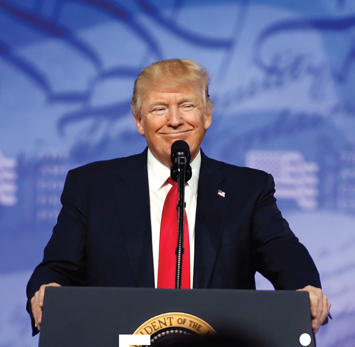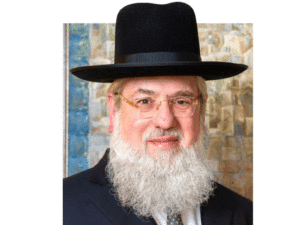Last week’s annual Conservative Political Action Conference at a convention center near Washington, DC, demonstrated the enthusiasm of virtually all segments of the Republican Party for Donald Trump’s presidential agenda. Those who had previously been skeptical of Trump’s conservative credentials were impressed and surprised by his victory over Hillary Clinton, as was everyone else. Since then, he has won them over by carrying out campaign promises to roll back Obama’s progressive policies while pursuing long sought Republican and conservative policy objectives.
Republicans and conservatives realize that for the first time since Ronald Reagan, there is an elected leader willing to stand up to determined opposition from the supporters of big government. President Trump is keeping his promise to follow conservative principles to reverse Obama’s failed liberal policies which led to economic stagnation at home and disrespect for the U.S. abroad.
Trump’s speech at CPAC’s Friday session highlighted the program. It galvanized the audience of 2,500 conservatives who stood up and cheered in response to the president’s renewed pledges to pursue their shared policy agenda. Trump railed against the Democrats and the “fake news” media which continues to mislead the American people about his intentions and to do everything in their power to discredit him personally while obstructing his ability to govern.
Conservatives wearing red “Make America Great Again” campaign hats roared their approval as Trump declared, “Our victory was a win for everyone who believes it’s time to stand up for America, to stand up for the American worker,” and also a “win for conservative values.”
KellyAnne Conway, special White House advisor, said the conference should have been named “TPAC,” the Trump Political Action Conference, because he has reinvigorated the conservative movement and broadened its base.
Conway said that Trump “went right to the grassroots and made people feel from the beginning they were part of this movement.”
Because of the opposition Trump’s candidacy faced from the outset, Conway said, “he earned the nomination in a way that was bottom up, instead of top down.” As a result, she said Trump became “the first candidate of his type, a non-politician, a true outsider, coming to shake up the system.”
“WE WILL NOT STOP UNTIL THE JOB IS DONE”
Some mainstream media reports complained that Trump’s CPAC speech contained nothing new. They had expected him to follow the pattern set by other Republican presidents before him who had backed away from the promises they made on the campaign trail to reach an accommodation with the entrenched political establishment in Washington.
Instead, Trump and the members of his administration have embarked on a determined effort to keep the commitments he made as a candidate.
He told the CPAC audience, “One by one, we’re checking off the promises we made to the people of the United States. One by one, a lot of promises. And we will not stop until the job is done.
“We will reduce your taxes, we will cut your regulations, we will support our police, we will defend our flag.
“We will rebuild our military. We will take care of our great veterans. . .
“We will fix our broken and embarrassing trade deals that are no good. . .
“We will cut wasteful spending. We will promote our values. We will rebuild our inner cities. We will bring back our jobs and our dreams.”
Trump reiterated his promises to deport criminal illegal aliens, secure the southern border, and repeal and replace Obamacare. Even before taking office, Trump took action, negotiating with the leaders of Carrier and other major corporations to rejuvenate the American economy and generate jobs.
Trump defended his right to attack the media as the “enemy of the people” when it knowingly reports fake news. “They are the enemy of the people because they have no sources, they just make ‘em up when there are none.”
IS THE MEDIA THE ENEMY?
The media reported Trump’s accusation against it by “dropping off the word ‘fake.’ And all of a sudden the story became the media is the enemy.”
Trump insisted, “I’m not against the media, I’m not against the press. I don’t mind bad stories if I deserve them. And I tell ya, I love good stories. . .
“I’m against the people that make up stories and make up sources. They shouldn’t be allowed to use sources unless they use somebody’s name.”
The president rejected criticism that he is an enemy of the First Amendment to the U.S. Constitution which guarantees freedom of speech. “I love the First Amendment. . . I mean, who use its more than I do? But the First Amendment gives all Americans the right to speak our minds freely and the right to criticize fake news.”
Trump noted that many of these purveyors of fake news “are part of the large media corporations that have their own agenda and it’s not your agenda and it’s not the country’s agenda. . . They have a professional obligation as members of the press to report honestly. But as you saw throughout the entire campaign, and even now, the fake news doesn’t tell the truth.”
ROLLING BACK OBAMA’S POLICIES
Trump has already rolled back several of Obama’s policies. He is about to re-issue his executive order to temporarily halt immigration from terrorist-infested failed states and cut down on the number of foreign refugees the U.S. will accept. He has re-authorized the construction of energy pipelines using American-made steel, which Obama canceled. To protect American jobs, Trump has withdrawn the U.S. from the Trans-Pacific Partnership.
He has ordered the leaders of the U.S. military to present him with a new plan for the defeat of ISIS. He has also renewed the U.S. commitment to its traditional allies abroad, but on the principle that America’s national and economic interests must come first.
Trump’s victory was the result of his success in expanding the GOP’s voter base by attracting the support of working class voters whose interests the Democrats have abandoned. To keep them in the fold, Trump renewed his pledge that “the forgotten men and women of America will be forgotten no longer. That is the heart of this new movement and the future of the Republican Party.”
Trump declared, “I’m here fighting for you and I will continue to fight for you. The victory and the win were something that really was dedicated to a country and people that believe in freedom, security and the rule of law.”
EXPANDING THE GOP BASE
He promised that “the GOP will be, from now on, the party also of the American worker,” to help preserve its current control of the federal government and most state governments across the country.
Trump recalled his first speech to a CPAC conference in 2011, when he had no thought of running and very little preparation. But his speech was well received, and it whetted his appetite for entering politics. “I said, ‘I think I like this business.’”
Trump chose not to appear at the CPAC conference last year as a candidate because he was “worried that I would be, at that time, too controversial.”
He was right. At the time, conservatives distrusted Trump’s commitment to their values. Establishment Republicans who had grown too comfortable in making deals with Democrats in Washington saw him as a populist outsider who threatened their power.
HIS ONLY SUPPORTERS WERE THE PEOPLE
The only ones supporting him were the millions of forgotten voters who yearned for a truly independent presidential candidate who would keep his promises and work for them, rather than another career politician who would fall under the influence of the special interest groups and their lobbyists as soon as they got to Washington.
Because Trump had no prior experience running for elected office, because his positions on many issues were outside the political mainstream, and because his campaign tactics were so unconventional, opponents made the critical mistake of underestimating him. Initially, Democrats encouraged the mainstream media to play up Trump’s candidacy, believing that he would be the easiest Republican opponent for Hillary Clinton to defeat. He benefitted from millions of dollars of free air time by making himself the most accessible candidate to the media. While other candidates restricted their media exposure and offered tightly scripted statements, Trump was always available for interviews and relished generating the headlines which enabled him to dominate most news cycles.
TRUMP’S OPPONENTS VIOLATED THEIR GOP PLEDGE
This led to an increasingly contentious relationship between Trump and the leaders of the Republican party. One of the many ironies of the primary campaign was that then-Republican National Committee chairman Reince Preibus required Trump, as a newly announced presidential candidate, to sign a pledge to support whichever GOP candidate won the nomination. By the end of the primary season, it was some of Trump’s most widely respected opponents for the nomination who violated that pledge. Despite his overwhelming string of victories in the GOP primaries, party leaders like House Speaker Paul Ryan expressed their reservations about Trump’s provocative style and his fitness to serve as the GOP standard bearer.
Even after Trump sealed the nomination, there were continued rumblings of a revolt brewing against him in the GOP by pledged convention delegates. The internal discontent was finally largely laid to rest by Trump’s inspired selection of Indiana Governor Mike Pence as his vice presidential running mate.
PENCE’S CONTRIBUTIONS
Pence was the perfect choice to balance the GOP ticket. While Trump was still considered to be an unpredictable political novice, Pence was a widely known and trusted figure in the conservative world. He was a successful governor and had a decade of experience in the House of Representatives, including two years as the chairman of the House Republican Conference.
Pence had the credibility to convince skeptical conservative and establishment GOP leaders to stick with Trump during the general election campaign rather than abandoning him in the face of intense media criticism of his every minor misstep.
Pence was an asset during the campaign, helping to keep the traditional GOP voter base and leadership on board and serving as the calm, reliable counterpoint to Trump’s bombast and celebrity charisma. Pence also put his personal credibility on the line, defending his running mate even when Trump was under intense criticism by Democrat opponents, the mainstream media and even a few wavering fellow Republicans.
Pence was even more valuable to Trump after their election victory, when he assumed control of the transition process after it got off to a stumbling start under New Jersey Governor Chris Christie.
The outstanding cabinet which Pence helped put together for Trump was the clincher for many conservatives who still had their doubts about the intentions of the president-elect. Since the inauguration, Pence has maintained a high profile as Trump’s personal representative, trusted advisor and liaison to the GOP leadership.
Pence’s speech at the CPAC conference the day before Trump’s appearance received a warm and enthusiastic welcome.
Pence declared, “Friends, this is our time. This is the time to prove again that our answers are the right answers for America.”
“THE OTHER SIDE IS NOT SITTING IDLE”
“We must all of us rise to the challenge before us, tomorrow and every day thereafter, [because] the other side is not sitting idle. Their allies in the media are more than willing to amplify their defense of the failed status quo every day.
“We’ve got to mobilize. We’ve got to march forward as if it’s the most important time in the history of our movement,” Pence warned, “because it is.
“This is the chance we’ve worked so hard for so long to see. This is the time to prove again that our answers are the right answers for America: A strong military. More jobs. Less taxes. Respect for the Constitution, and the values that have made America great, and a deep and abiding faith in the goodness of the American people
He added, “it is the greatest privilege of my life to be the vice president of a president with conviction and courage. . .
“He will never stop fighting until we make America great again. You elected a man for president who never quits or backs down. He is a fighter and a winner.”
Pence said that Trump reminded him of Ronald Reagan, who “gave voice to the aspirations of the American people like no leader of the [20th] century.”
Pence declared that the Trump administration is in “the promise keeping business these days.”
ISSUES CLOSE TO CONSERVATIVE HEARTS
He touched on issues that are close to conservative hearts. He reminded them, “in Judge Neil Gorsuch, President Trump kept his word” to nominate a suitable replacement for the late Justice Scalia, who would uphold his approach to applying the original intent of the authors of the Constitution to the cases that will come before him rather than inventing new rights that suit the liberal popular culture.
He added that Trump, “is restoring the culture of life, defending the Constitution and leading the fight to repeal and replace Obamacare.”
The vice president said that under the Trump administration, no state will be required to adopt the controversial Common Core curriculum for its public schools. That is a matter which most conservatives feel is best left to the discretion of the states and local school boards, rather than dictated by the federal government.
The crowd cheered again when Pence said of Israel, “Her fight is our fight, her cause is our cause, her values are our values.”
The vice president took special pride in describing how Trump charged him to select the new cabinet. “When President Trump asked me to chair the transition, he looked at me and said, ‘Mike, just get me the best,’” Pence said.
The picks for Trump’s cabinet which resulted from Pence’s efforts were better than most conservatives had dreamed possible. As Pence ticked off the names of each of Trump’s cabinet appointments, each one was met with roaring applause from the CPAC audience.
“How about that Attorney General Jeff Sessions? How about General Jim Mattis over at the Pentagon? How about Ben Carson at the Department of Housing and Urban Development?
“I can go on and name every single one of them and I am proud to say to you folks that this is the A-team. President Trump has assembled the most conservative cabinet in my lifetime,” Pence asserted, and nobody in the audience seemed inclined to disagree.
THE SHAKY GOP MAJORITY IN THE SENATE
Pence didn’t mention the name of Education Secretary Betsy DeVos, who was a main target of Senate Democrats eager to show their supporters that they could defeat at least one of Trump’s cabinet nominees. Democrats managed to pick off two Republicans who announced that they would oppose her a few days before DeVos’ confirmation vote. That left the Senate split 50-50. The remaining Republicans stood firm in the face of intense media pressure, which enabled the tie-breaking vote confirming DeVos to be cast by Pence in his constitutional role as the presiding officer of the Senate.
The tie vote over DeVos’ confirmation highlighted the fact that 2-vote Republican majority control of the Senate can be shaky, especially on controversial issues. Senator Ted Cruz of Texas told reporters covering CPAC that Republicans owe a debt of gratitude to former Democrat Senate Majority Leader Harry Reid for doing away, in 2013, with the Senate rule requiring at least 60 votes to confirm a cabinet appointee or lower level federal judge.
Without that change, Democrats would have been able to block many of Trump’s cabinet picks by mounting a filibuster to delay the confirmation vote indefinitely. Under the old Senate rules, at least 60 votes were required to invoke cloture to end debate on a nominee for confirmation. That would force an up or down vote on the nomination to be decided by a simple majority.
THE IMPORTANCE OF THE “NUCLEAR OPTION”
Invoking the so-called “nuclear option,” Reid changed Senate rules to require a simple 51 vote majority for cloture to get around an effort by Senate Republicans to stymie confirmation of President Obama’s liberal judicial picks for the lower federal courts.
Reid also eliminated the 60 vote requirement for cloture from the Senate’s confirmation process for cabinet appointees, which made it impossible for Senate Democrats to block any of Trump’s picks without help from at least three Senate Republicans.
With that Senate rule still in force, Cruz said that President Trump should now be able to pack the lower federal court benches with conservative judicial picks. “I would like to see an army of young, principled constitutionalists on the bench, a generation of new leadership, a generation of 30-something and 40-something Scalias and [Clarence] Thomases,” Cruz said.
The new Senate rule does not apply to the confirmation of presidential nominees to fill vacancies on the Supreme Court, which still require a 60-vote majority to keep a filibuster from blocking a final vote. It had been feared that Democrats might filibuster the vote to confirm Judge Gorsuch to fill Justice Scalia’s vacant seat, but Gorsuch’s obvious qualifications have made his nomination popular with enough Democrat Senators that it now seems unlikely that there will be a serious effort to block his confirmation.
FUTURE CONTROL OF THE SUPREME COURT
Democrats are also not eager to put up a fight because the confirmation of Gorsuch would only restore the ideological balance of the court to what it was when Scalia was alive. There were 4 liberal judges and 4 conservative judges with the deciding vote in hotly contested 5-4 cases usually cast by Justice Anthony Kennedy. He is a centrist leaning conservative who was appointed by Ronald Reagan and is now 80 years old. Justice Ruth Bader Ginsburg, one of the court’s most liberal voices, at 83 is also well past normal retirement age and has survived two bouts with cancer. Liberal Justice Stephen Breyer, at age 79, is the next oldest member of the high court, but appears to be in good health.
It had been speculated that Ginsburg might choose to retire while Obama was still president to assure that she would be succeeded by another liberal judge, but she has voiced her determination to stay on the bench as long as she can. Now speculation centers around the possible retirement of Justice Kennedy. That is what Senator Cruz was probably referring to last week when he told the CPAC audience, “This summer, I think we’ll have another Supreme Court vacancy.”
Cruz predicted that the left would wage an all-out battle against confirming Trump’s choice of a replacement for Justice Kennedy if he chose to retire.
During the campaign, Trump released a list of 21 names of potential conservative Supreme Court picks, including Gorsuch, which he had compiled with the help of then-Senator Jeff Sessions. Any of them would alter the ideological balance of the court, giving conservatives a clear 5-4 majority over the liberals.
OVERTURNING 40 YEARS OF LIBERAL DECISIONS
The conservative judges could then overturn any of several controversial liberal decisions by the Supreme Court, going back more than 40 years to the Roe v. Wade decision in 1973.
Liberals would fight tooth and nail to protect those decisions, some of which have had a major impact on public policy, but they will again be at a disadvantage because of the precedent which Harry Reid set. If Senate Democrats sought to filibuster Trump’s next Supreme Court pick, Republican Senate Majority Leader Mitch McConnell could follow Reid’s example. He could invoke the nuclear option to revoke the remaining Senate rule requiring a 60-vote supermajority to invoke cloture for Supreme Court nominations and force an up or down confirmation vote decided by a simple majority.
Control of the Supreme Court is one of two more political prizes that conservative Republicans seek in order to reshape federal government policy.
GOP ANTICIPATING THE 2018 SENATE ELECTIONS
The GOP is eagerly looking forward to the 2018 midterm election, when Democrats must defend the Senate seats of 10 of their incumbents in states which Trump carried in November. If Trump and the Republicans can hold all of their current Senate seats in 2018 and capture at least 8 seats held by vulnerable Democrats, they would hold a 60 vote Senate super-majority. They could then dictate their own federal policies, regardless of Democrat opposition.
This is why Cruz and other Republican strategists predict that the obstructionist tactics of the Democrats will only intensify as the 2018 election nears.
One of those strategists is Steve Bannon, Trump’s highly controversial senior White House advisor who was the main ideological influence during the final months of Trump’s campaign. Bannon and White House Chief of Staff Reince Priebus made a rare joint public appearance at the CPAC event. Their goal was to silence persistent media rumors that Trump’s top two White House advisors are in a cutthroat competition for power behind the scenes.
At CPAC, they acted like the best of friends. Event chairman Matt Schlapp of the American Conservative Union asked Priebus and Bannon, “What is the biggest public misconception about what’s going on in the Donald Trump White House?”
EVERYTHING YOU’RE READING IS WRONG
Priebus, answering on behalf of himself and Bannon, said, “The biggest misconception is everything that you’re reading. We share an office suite together, we’re basically together from 6:30 in the morning until about 11:00 at night. . .
“Our job is to get the agenda of the president through the door on pen and paper.”
Priebus added that despite “the ridiculous stories” in the media, “all we do every day and all President Trump does every day is hit his agenda every single day. Whether it’s TPP, deregulation, Neil Gorsuch, whatever it is, his promise is coming through every day.”
Priebus credited Trump for “bringing together the party and the conservative movement. And I’ve got to tell you, if the party and the conservative movement are together, similar to Steve and I, it can’t be stopped.”
Bannon called Trump “the greatest public speaker since William Jennings Bryan,” the Nebraska congressman who ran unsuccessfully as the Democrat presidential candidate three times, beginning in 1896, and served as Secretary of State under President Woodrow Wilson.
WHAT THE MAINSTREAM MEDIA DOESN’T UNDERSTAND
He said that the mainstream media, which Bannon, Trump and many others see as the “opposition party,” has never caught on to the fact that Trump’s policy agenda was all contained in the agenda he laid out in his campaign speeches.
Bannon predicted that relations between the Trump administration and this “opposition party” will “get worse every day” as Trump’s agenda begins to show the desired results. “As economic conditions get better, as more jobs get better, they’re going to continue to fight. If you think they’re going to give you your country back without a fight, you are sadly mistaken.”
Bannon said that since he joined the Trump campaign as an advisor, “since August 16, when you look at the opposition party and how they portrayed the campaign, and now portraying the administration, it’s always wrong. . .
“If you remember, the campaign was the most chaotic by the media’s description, most unprofessional, and didn’t have any idea what they were doing. Then you saw them crying and weeping that night [that Trump won the election.]”
According to Bannon, Trump is now “maniacally focused” on carrying out the promises he made to the American people during the campaign. During the transition, when “many people tried to come in to convince President-elect Trump, you won on this, but this is what you want to do. He was like, no, I promised the American people this, and this is the plan we’re going to execute. . .
“That’s what the mainstream media won’t report. Just like they were dead wrong on the chaos of the campaign and then in the chaos of the transition, they’re dead wrong in what’s going on today. We have a team grinding it through. President Trump is following through on what he promised the American people, and the mainstream media better understand something: all of those promises are going to be implemented. It’s awesome,” Bannon said.








